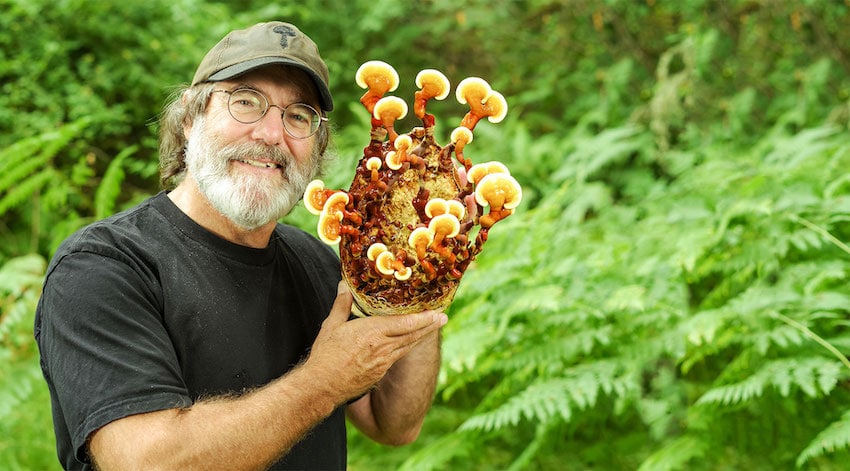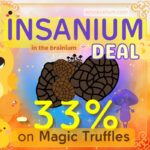Is there sustainable research happening up there? Or is it just billionaires (and living legend William Shatner) going on jollies in the great wide unknown?

Introducing Astromycology
Well — it turns out scientists actually have been beavering away working out the hows, and the whats and the whys — and NASA is now funding a little thing they’re calling ‘astromycology’.
Astro? Mycology?
Yep! You got it in one! It’s mushrooms in space! And, the venture is being helmed on the mycological-side by none other than mush-master Paul Stamets!

If you’re a bit of a shroom-head yourself, you may know iconic psychonaut Terence McKenna’s theory that mushrooms actually came from space. Although captivating, it as of yet, cannot be proven. However, it does set the stage for mushrooms being seen as something out of this world, and speaks of their almost unnatural natural qualities.
So how do these qualities make them perfect for furthering the possibilities of space exploration?
For feeding, housing and powering our future cosmic home? Well, in a recent interview Stamets revealed all…
Growing Food In Outer Space
If you are planning to populate a planet, or at least stay there for more than a long weekend, you are going to need a sustainable way of producing food. Of course, you can’t just drop seeds onto the surface of an inhospitable terrain. This is where mushrooms come in. Stamets explains;
“[Plants that support terraforming] need minerals, and pairing fungi up with the plants and debris from humans [causes them to] decompose into a form that then creates rich soils that could help generate the foods that astronauts need. It’s much easier to take one seed and grow your food than it is to take a ton of food to space, right?
Nature is incredibly efficient in terms of a payload. It’s much better for nature to generate a payload of food than for your rocket to carry a payload of food.”
It sure makes more sense than packing 10 years worth of frozen pizzas into a rocket!

One of the crucial hopes of this process is that the mushrooms will be able to interact with the elements found on the planets we hope to terraform. Stamets explained how researchers have created a synthetic version of the regolith found on other planets. Regolith is asteroid dust. And, it turns out oyster mushrooms are pretty good at breaking it down. Even better when paired with other types of fungi too — as on Earth, diversity is key! Stamets describes the process:
“They become a resource that provides vitamins, other minerals… which can fuel these fungi to grow even larger and then support more plants that create more cellulose. And then they die, and they decompose, and these lenses of mycelium… then begin to grow out more and more… And as their communities become more diverse and complex, these lenses of life then begin to become larger oases. And when the oasis environment is large enough, then it can sustain humans.”
Building In Outer Space
Another thing you don’t really want to be lugging around in your rocket is heavy building materials. Well — no surprises here — there’s a shroom shaped solution for that too! Turns out, one of our fave superfood mushrooms could actually be key to growing sustainable building materials on other planets! Three cheers for the reishi mushroom! However, it was just by chance that it was discovered as the space architect’s material of choice. Stamets gives us the story:
“We grow reishi blocks. We wanted to crush these blocks in order to turn them into soil… But we couldn’t crush them. You could saw them with a saw blade, but if you tried to hit them with a hammer or something, they just wouldn’t break. So this great engineer built us a hydraulic stainless steel press… and we gave it my reishi blocks, and it bent the stainless steel.
Trying to compress it, it actually broke the machine. This thing will crush rocks all day long and could not crush mycelium…They’re so structurally strong.”
But not only are reishi mushrooms turning astromycologist’s heads as the self-growing brick de jour. They also have a few more tricks up their sleeve. Stamets describes the heat retaining and insulating qualities of the reishi blocks as ‘phenomenal’. He also believes that due to their high levels of carbon these reishi mycelial blocks could be used as batteries or solar panels.
“…they could then not only insulate you from the cold on the Martian or asteroid surface, but the house itself becomes a giant battery for power because they’re so rich in carbon fibers. So that, to me, is really cool.”
Very, very, cool indeed Paul!
Tripping In Outer Space
Lastly, Stamets laid out some psychedelic thoughts for the cosmos. Of course, the potential to sustain human life in outer-space is key, but the quality of that life is just as vital. Even for trained astronauts, the true realities of the intense psychological strain — fear, boredom, loneliness — caused by being in space, can overwhelm. Stamets believes that psilocybin mushrooms, finally being acknowledged for their healing properties on Earth, could be essential healing for those flung out into the deep, dark universe too.
“Do you think the astronauts are going to have loneliness and depression and PTSD? I think yes. How are you going to help them?
Under carefully controlled conditions, our astronauts [being] able to take psilocybin in space and look at the universe and not feel distant and alone but feel like they’re part of this giant consciousness will give them a better frame of mind—psychologically, emotionally… I feel that isolation, loneliness and depression are going to be major issues that astronauts face.”

Firstly, like, how amazing would it be to trip in SPACE?! And secondly, just as with folks on Earth, magic mushrooms could help the astronauts be the best they can be. And why not populate the stars with those enriched by the creative, generous and caring energy that psilocybin gives?
Stamets muses:
“…people who are more creative come up with more solutions. I think that, in a sense, is a fertile ecosystem that can lead to the sustainability of humans in space.”
So, could this be the future? Growing food from mycelium soil, living in a house made of mushroom bricks, powered by mushroom batteries, with ideas powered by mushroom induced creativity — on MARS?

Sounds just about crazy enough to be true!

 INSANIUM Deal
INSANIUM Deal 

 Combo deals >
Combo deals >

 Strength up to 110/100
Strength up to 110/100 
 %
%
 500 gr.
500 gr. 
